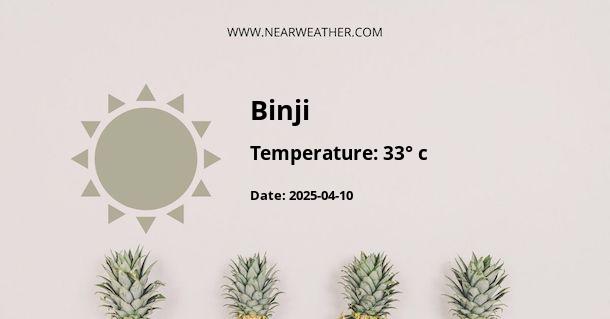Climate and Weather in Binji, Nigeria
Binji is a town located in the Sokoto state of Nigeria. It is known for its unique climate and weather patterns throughout the year. Understanding the climate of Binji is essential for residents, tourists, and businesses alike. In this article, we will explore the climate and weather conditions in Binji, providing detailed information about temperature, rainfall, and other important factors.
Temperature
Binji experiences a tropical savanna climate, characterized by high temperatures throughout the year. The town is located in the northern region of Nigeria, which is closer to the Saharan desert. As a result, the temperatures in Binji can reach extreme levels, especially during the dry season.
The hottest months in Binji are typically March and April, with average daily temperatures ranging from 35 to 40 degrees Celsius (95 to 104 degrees Fahrenheit). During this time, it is important to take necessary precautions to protect oneself from heat-related illnesses.
Even during the cooler months, the temperature in Binji remains relatively high. From November to February, average daily temperatures range from 30 to 35 degrees Celsius (86 to 95 degrees Fahrenheit). The nights are generally cooler, with temperatures dropping to around 15-20 degrees Celsius (59-68 degrees Fahrenheit).
Rainfall
Binji experiences a distinct wet and dry season, typical of tropical climates. The rainy season in Binji usually starts around May and lasts until September. During this period, the town receives the majority of its annual rainfall.
The average annual rainfall in Binji is around 800 to 1000 millimeters (31 to 39 inches). However, there can be significant variations in rainfall from year to year. The heaviest rainfall months are typically July and August, with some occasional heavy downpours and thunderstorms.
During the dry season, which spans from October to April, rainfall is significantly reduced. The months of December to February are particularly dry, with little to no rainfall. This dry period can lead to drought conditions and water scarcity in the region.
Humidity
Binji experiences relatively high humidity levels throughout the year. The proximity to the Saharan desert and the tropical climate contribute to the humid conditions in the area. Humidity levels can range from 60% to 90%, making the air feel quite heavy and muggy.
Wind Patterns
Binji experiences a prevailing wind pattern from the northeast, known as the Harmattan wind. The Harmattan wind blows in from the Sahara desert and brings dry and dusty conditions to the region. This wind is most common during the dry season, particularly from November to February.
The Harmattan wind can have a significant impact on the climate and weather in Binji. It leads to a decrease in humidity levels and can cause visibility issues due to the dust in the air. It is important to take necessary precautions, such as wearing protective clothing and staying hydrated, during this period.
Climate Change and Future Projections
Like many other regions around the world, Binji is also facing the impacts of climate change. Rising temperatures, changing rainfall patterns, and increased frequency of extreme weather events are some of the notable effects.
According to climate projections, Binji and the surrounding areas are expected to experience even higher temperatures in the future. This could lead to more frequent heatwaves, increased water scarcity, and challenges for agriculture and livestock farming.
Additionally, there are concerns about the impact of climate change on rainfall patterns in Binji. It is projected that there may be a shift in the timing and intensity of rainfall, which could have implications for water availability and agricultural practices in the region.
Conclusion
Binji's climate is characterized by high temperatures, distinct wet and dry seasons, and the influence of the Harmattan wind. Understanding the climate and weather patterns in Binji is crucial for residents, tourists, and businesses to plan and prepare accordingly. As the impacts of climate change continue to be felt, it is important to take proactive measures to mitigate and adapt to these changes.
A - Binji's Latitude is 13.222770 & Longitude is 4.909550.
A - Weather in Binji is 27° today.
A - Climate Conditions in Binji shows overcast clouds today.
A - Humidity in Binji is 20% today.
A - Wind speed in Binji is 12.85 km/h, flowing at 118° wind direction. today.
